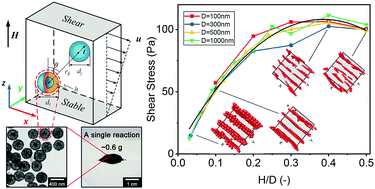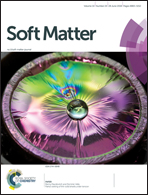Simulation of the optimal diameter and wall thickness of hollow Fe3O4 microspheres in magnetorheological fluids†
Abstract
This work reported a simulation study on the optimal diameter (D) and wall thickness (H) of hollow Fe3O4 microspheres to improve the magnetorheological (MR) effect. Modified formulae for the magnetic dipolar force, van der Waals force, and hydrodynamic drag force were employed in the simulation model. Typical evolution of shear stress and microstructures in steady shear flow was obtained. The shear stress–strain curve was divided into linear, fluctuant, and homeostasis regions, which were related to the inclination of particle chains and the lateral aggregation. For hollow Fe3O4 microspheres with different diameters and wall thicknesses, the shear stress curves collapsed onto a quadratic master curve. The best wall thickness was H = 0.39D for a 20 wt% MR fluid and H = 0.35D for a 40 wt% MR fluid, while the optimal diameter was D = 1000 nm and D = 100 nm, respectively. The maximum shear stress of the 40 wt% MR fluid was twice that of the 20 wt% MR fluid. The change of shear stress was due to the competition that results among the magnetic interaction, number of neighbors, tightness, and orientation of the particle chains. Simulated dimensionless viscosity data as a function of Mason number for various diameters, wall thicknesses, and weight fractions collapsed onto a single master curve. The simulated shear stress under both a magnetic field and shear rate sweep matched well with experiments.



 Please wait while we load your content...
Please wait while we load your content...